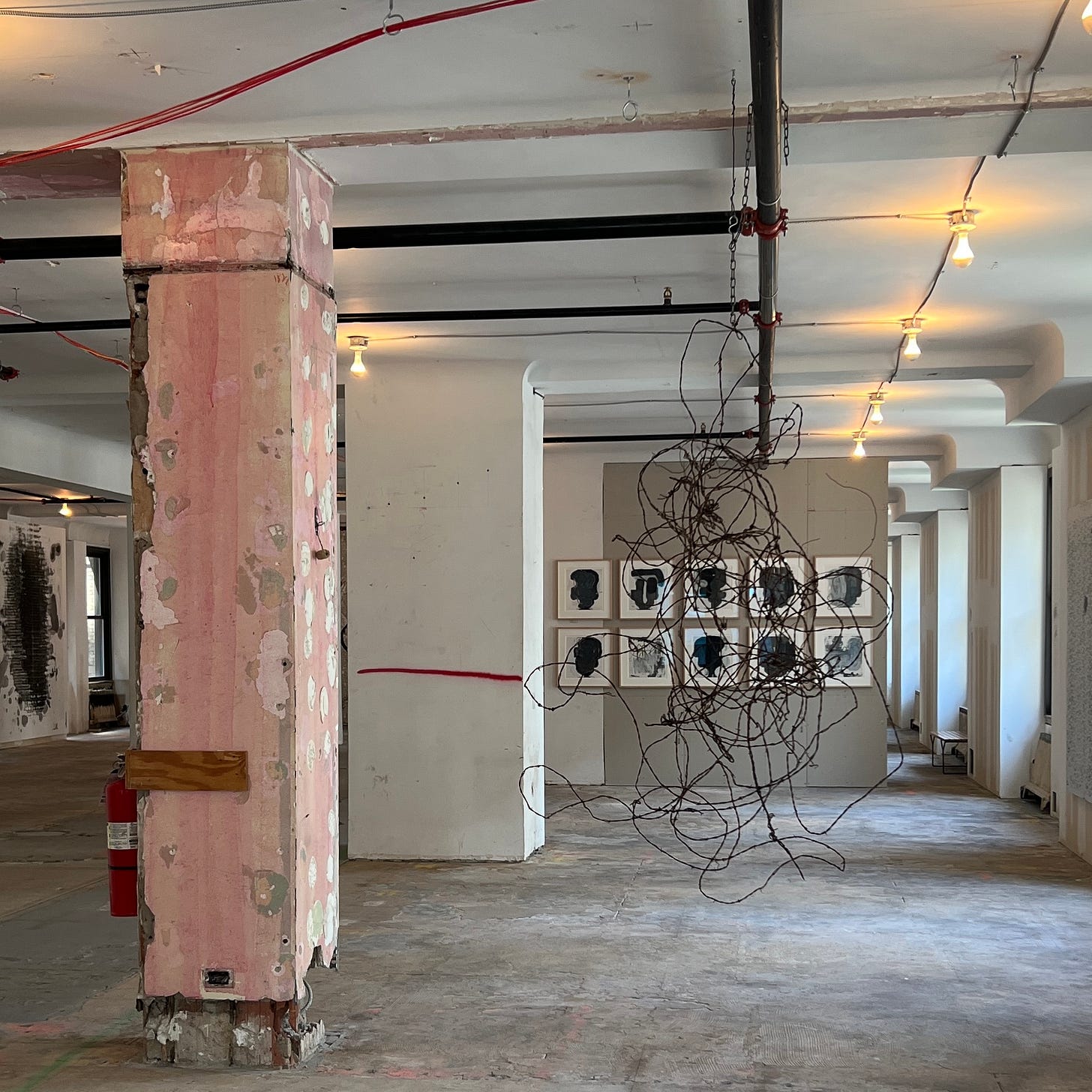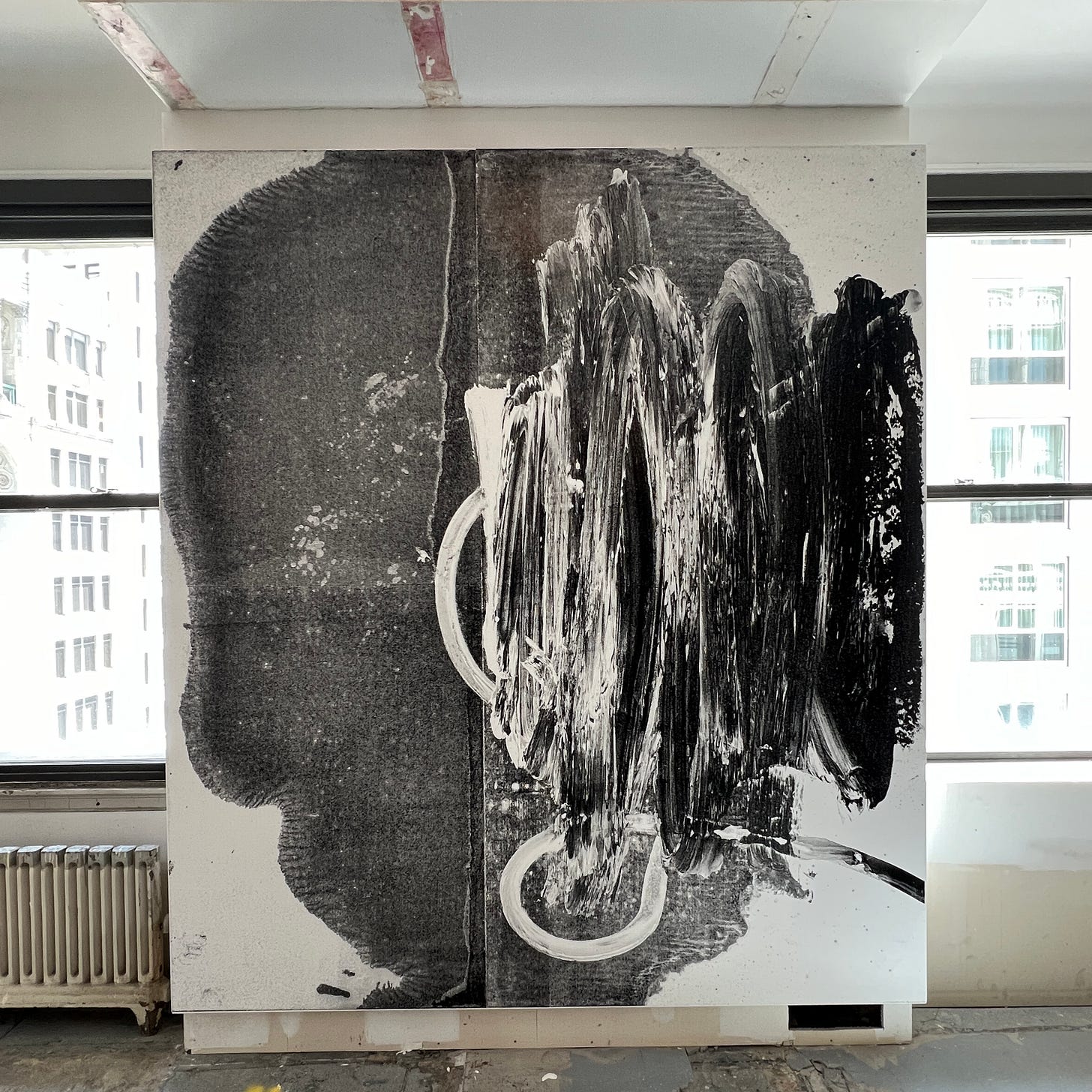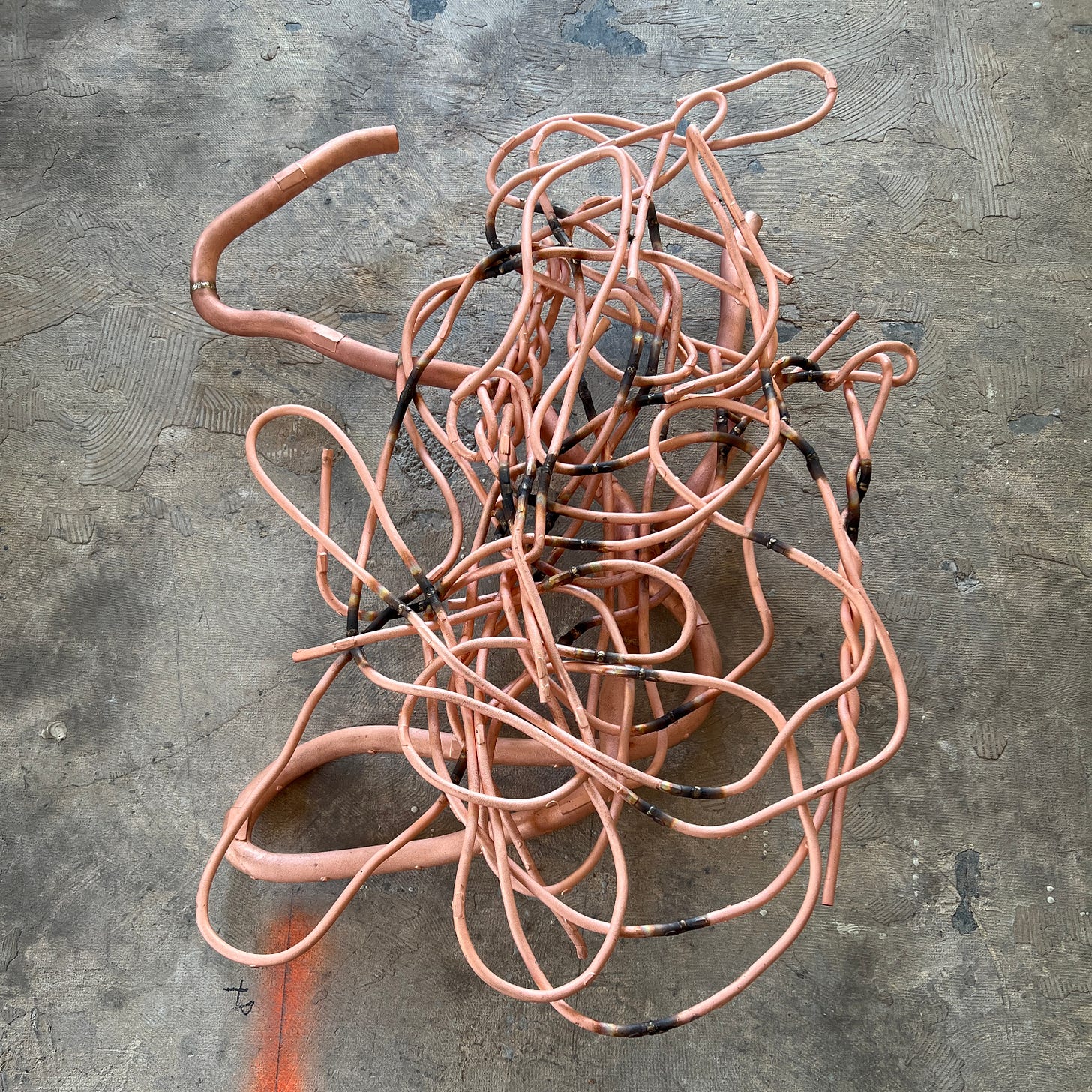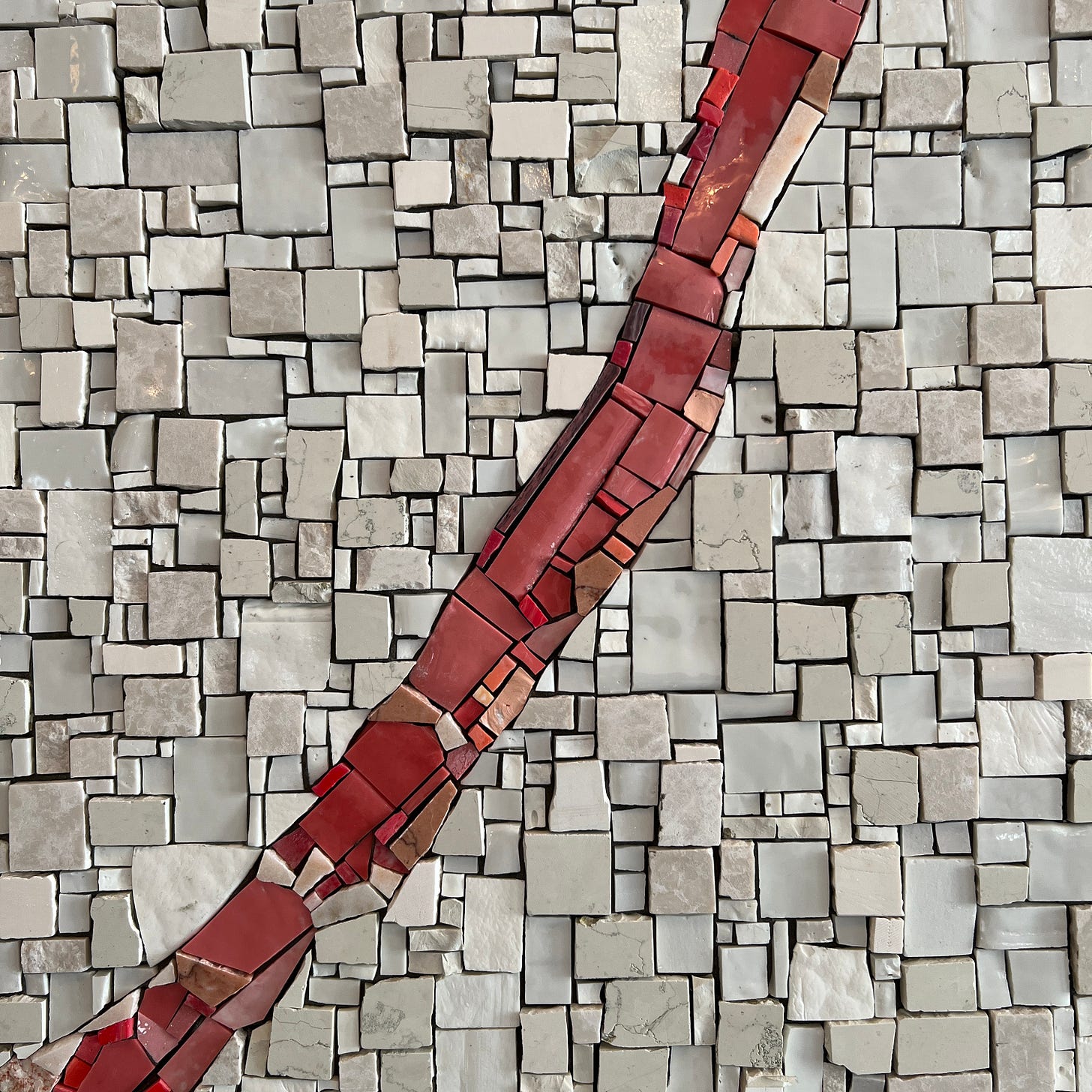Note: I saw this show twice, but only felt compelled to write about it after it had closed. Unable to find a checklist online, I skipped the captions. My apologies to the artist.
Born of a mollusc, Botticelli’s Venus emerges from the Mediterranean Sea. Christopher Wool’s non-objective muse—let’s call her the Spirit of Gestural Abstraction—rises from the rubble of commercial real-estate. His recent exhibition on the ruined 19th floor of a centenary office tower popped-up like a magic rabbit and was greeted accordingly.
At a 16% vacancy rate, Lower Manhattan property owners are doing better than blue chip artists. Wool’s secondary market results—the ones that justify his retail prices—have tumbled lately from wild highs, along with the art market generally. No worries. I wager that this show will correct Wool’s reversal and maybe even distract a few viewers away from his numbers.
The exhibition had an elegiac “dust to dust” air that felt like this moment. And it was touching enough to postpone hasty evaluations of the artist’s erratic shapes. Wool’s work requires initiation. Rough, blunt, and opaque, it isn’t prone to love at first sight. But a longer look reveals an intellectual seriousness, a deep understanding of the modernist heritage, and the energy to keep things moving.
This artist is fearless. If the show reaffirms him as a solid venture, much of it was indistinguishable from rubble: a jumble of rusty wire hung like a glib construction worker’s mobile; an informe idol in weathered concrete sat on a pedestal like an excavated Arp; pink and white scribbles, framed and matted, were nailed to pock-marked pillars stained fire-retardant rose. To dignify the squatter ambience, a century of renovations from a palimpsest of tenants revealed Gilded Age tile work here and there. I thought of Byzantine mosaics in Tunisian dirt.
Wool’s big fitful smear pictures filled a few walls between the windows. At first, I saw grisaille versions of Greenberg’s “Tenth Street touch,” the full-armed thrusts of priapic Willem de Kooning. Then I noticed that two of the canvases were as identical as photocopies, which they suddenly resembled uncannily. His paintings, prints, and drawings, like the other things on display, are representations of a plastic idiom from which they take their distance. Media imitating media, it’s a side-ways tribute to abstraction, perhaps, but also a grim pastiche.
Wool likes his media plural: painting, silkscreen, lithography, ink-jet, air brush, drawing, carving, casting, photography and detritus recycled as art. He often combines them—painting on lithograph, airbrush on silkscreen—to increase complexity and cause a semiotic turbulence that scrambles object and subject. As you might guess from his nationality, he pulls it off with Puritan economy.
It wasn’t long before I started thinking about chaos theory, the mathematical idea that turbulence might not be predicted, but it can be modelled and therefore understood. A breakthrough for ratiocination, I saw it as a blow to the mystique of the ineffable. Chaos theory entered the discourse when Wool was in his twenties. Did it inform his materialist practice? There’s a whiff of philosophy in here, therefore of science and, by extension, of truth. Truth is the aim of representation and of mathematical abstraction, not of abstract art, which aims for authenticity. Wool’s work, then, isn’t what it appears, or rather it is and it isn’t, in the way that Jasper John’s flag will rouse patriots but frustrate wavers.
If this work was not made by a modernist zealot, it isn’t seditious or satirical for all that. From the scribbled objects to the derelict space, everything matched in this call-and-response exhibition, and everything corresponded to the theme of turmoil. The art deco views from this perch turned Lower Manhattan into a 20s accessory to vanitas; not quite the last panel of Thomas Cole’s The Course of Empire, but foreboding nonetheless. Each work in the show was an erasure of sense gesticulating toward nothingness.
Or was it? Speaking of mosaics, at one end of the floor-through, horseshoe-shaped gallery, one work qualified all the rest, not as a selection of intemperate outbursts, but as an orchestrated proposition. A wall mosaic, large and painstaking, re-enacts the athletic loops and the blasé drips of a gestural painting as if commemorating a meaningful event. Seeing it confirmed this as a show of representations, pictures of heroic abstraction, but not the thing itself. Wool’s emotive paintings, for example, aren’t brush work at all but jittery Warholian prints. The many thickets of jumbled wires and pipes are carefully cast to look random. The opposite of spontaneous, every crafted object accords with the meticulous mosaic. This is an elaborate argument, not the exhibitionism of self.
Abstraction’s desert saints, aficionados of self, borrowed their ‘theme and variation’ approach from music, an art born abstract. Wool expands the remit of ‘theme and variation,’ well beyond style, to include supports, procedures and location. With his proliferation of media and his curation of site, he pushes formalism out into the sunlight where it hardens into a nut. He crack’s the nut and exposes non-objectivity as a shell concealing a sign, the one sign abstraction can’t evict: the sign of its self.
Is Wool casting doubt upon the dogma that artistic communication withstood the purgation of its referents? Yes and no. No because art did survive the purge, it’s settled law. Yes because the medium is Wool’s message, the crafty ‘how’ and not the vacant ‘what,’ so not immaculate abstraction, which he splits into an emissary and a symbol.
Encrypted by complexity, Wool’s message skulks behind a modernist ruse we might call aposematism, a trick to separate the enlightened from the benighted. Like an ugly, garish creature signalling toxicity to ward off predators, his work is brazenly aposematic compared to dissembling abstraction, which has elicited derision for over a century. “Well if it’s going to be like that,” Wool seems to say, “let’s run with it, let’s take it to town.”
Shamelessly, he actively solicits know-nothing gibes like ‘my kid could do that’ by crafting strong bait for rubes. Every work in this show is a fool-proof test that neither fine shoes nor fine manners can cheat. You either get it, or you don’t. Explaining Christopher Wool is an afternoon of self-doubt for the explainer. That makes it orthodox modernism. To receive the mediated message behind the turbulent facade, one must know the magic of disorder and agree that it has a place in art. If that’s a lot to ask of the average bear, it’s alluring as hell to aesthetes and to joiners of exclusive clubs.
A style of mark-making as close to dance as it is to painting, gestural abstraction records entranced movements of the hand, the arm or, in the case of Mitchell, Pollock, de Kooning, Kline and Clark, the whole body. Bearing witness to life, it charts animated consciousness and nothing else. It was the bold American instance of an international style, a prominent feature of the larger field of abstraction. Harold Rosenberg called it “Action Painting,” Clement Greenberg said it was “American-type painting,” and Robert Motherwell the “New York School.” Spontaneous, patriotic, energetic, expansive, effusive, and cool, it has no business being a mosaic.
By preferring medium to expression for his iteration, Wool awakens a quintessential American style to full-blown self-consciousness. He questions the authority of his object of filial devotion and begs to correct its conceits. With his signature punk palette, Wool shoos the lingering woo-woo out of Ab Ex, a disenchantment that seeks re-enchantment on materialist terms. And he asks a new question: can wonder survive knowledge? He’s asking for Richard Rorty’s “ironic liberal” who, short of immutable truths, depends on the arts for solace. Despite its superficial pessimism, Wool’s work answers yes.
Photographs are conscripted to stoke the melancholy and fan the turmoil. In the two series that I looked at, Wool’s revisionist ideas enlist photography’s freight of non-artistic baggage to release a fresh stream of turbulence. If his studio work makes the point that the deliberate mark is inevitably significant and unavoidably meaningful, even if its intention was asemic, Wool’s camera work makes a separate point. In one set of pictures, he rubs salt on philistine irritation by making the point retroactively. Snapshots intended as evidence for an insurance claim after a fire in his studio are transformed by fiat into art. A happy marriage of Weegee and Aaron Siskind, blessed by Marcel Duchamp, these photos work in the way that the Bechers’ serial photographs of industrial structures work: they demonstrate that aesthetic decisions are also inevitable, the yin to signification’s yang. And they work in the way that Kurt Schwitters meant when he said “What an artist spits is art.” Wool may be a materialist, but an artist is a shaman.
A second series of photographs is conventionally conceptual, and more poignant. Of course in black and white, it’s a suite of country views, each featuring a dirt road that was bulldozed through nature. In the context of a well-lit, but dark exhibition alive with dread, and like the personal disaster shots down the hall, this too is an inventory of loss. Smithson’s last ramp came to mind, followed by Joni Mitchell’s parking lot.
Eventually, I came upon a big table and flipped through large books of hi-res reproductions. Page after splendid page of gestural exercises rattled my premise of high concept. Overcome with covetousness, I heard Bartók, mystically, as my hermeneutic house of cards clocked a tremor. If I’m not quite ready to abandon the idea of Wool deep in thought with his elbows on a desk, he is one industrious aesthete in the studio. What I took to be a postulate of emptiness, was an example of exuberance and rigour. Then it hit me. Just as the meaning of life is life, the point of art is more art.











Ahhh to the ease in all that precision and constructed detritus. Thank you for wording so eloquently 👌🏼💥
Beyond brilliant. So look forward to seeing you soon.